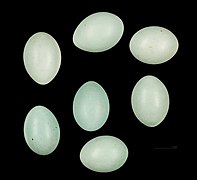Sakalave weavers
| Sakalave weavers | ||||||||||||
|---|---|---|---|---|---|---|---|---|---|---|---|---|

Sakalave weaver ( Ploceus sakalava ), male in magnificent dress |
||||||||||||
| Systematics | ||||||||||||
|
||||||||||||
| Scientific name | ||||||||||||
| Ploceus sakalava | ||||||||||||
| Hartlaub , 1861 |
The Sakalavenweber ( Ploceus Sakalava ), sometimes called Sakalavaweber called, is endemic to Madagascar occurring bird from the family of weaver birds (Ploceidae). The specific epithet refers to the Sakalava ethnic group living mainly on the west coast of Madagascar .
features
Sakalave weavers reach a body length of 15 centimeters and a weight of 20 to 28 grams. There is a clear sexual dimorphism between the sexes . In the splendid dress during the courtship and breeding season, the head, throat and chest of the male are brightly colored yellow, the back plumage is gray-brown. The gray-brown arm and hand wings are lined with whitish. The belly and flanks are light gray. In the plain dress , the head and throat are gray-brown. In terms of color, they then correspond to the females who wear a simple, brownish plumage all year round and resemble female house sparrows ( Passer domesticus ).
Distribution, subspecies and habitat
In addition to the nominate form Ploceus sakalava sakalava , which occurs in northwest Madagascar, another subspecies is known: Ploceus sakalava minor ( Delacour & Berlioz , 1931), which is native to the southwest of the island. The species prefers to colonize dry regions rich in bushes from sea level to altitudes of a maximum of 1000 meters.
Way of life
The birds are primarily seed-eaters and feed, for example, on grains of rice ( oryza ). Insects and spiders (Araneae), which are increasingly collected during the rearing of young, serve as additional food . The breeding season is determined by the local rainy season and is very different from region to region. In the north of Madagascar it falls in the months of September and October, in the west in the period from November to April. The nest is woven by both sexes from twigs, grass, soft plant fibers and strips of palm leaves. It is retort-shaped, has a 17 to 40 centimeter long tunnel-like entrance and is attached to branches between two and 25 meters above the ground. The nests are created in colonies of 10 to 120 nests per location and up to 40 nests in a tree. Sometimes nests are placed below the clumps of the Madagascar sea eagle ( Haliaeetus vociferoides ), the Madagascar buzzard ( Buteo brachypterus ), the black kite ( Milvus migrans ) or the tortoise-shell ( Corvus albus ). The birds expect better protection from predators. Notwithstanding this, nestlings are sometimes stolen from the Madagascar cave harrier ( Polyboroides radiatus ) or eggs from the brown maki ( Eulemur fulvus ). Occasionally, nests are attached to the roof edge of thatched houses. The nest is equipped with two to four bright greenish-blue eggs. Both parents provide the young with food. Details on the incubation period and the nestling time are not available.
Danger
Sakalave weavers are common and common in Madagascar. In some areas they are closely connected to people and are protected due to a local tradition, as they are considered to be good luck charms. Many animals are captured by barn owls ( Tyto alba ), but this does not endanger the population. Sakalave weavers are therefore classified by the World Conservation Organization IUCN as ![]() “ least concern = not endangered”.
“ least concern = not endangered”.
Individual evidence
- ↑ a b c d A. Craig (2017). Sakalava Weaver (Ploceus sakalava). In: J. del Hoyo, A. Elliott, J. Sargatal, DA Christie & E. de Juana (eds.). Handbook of the Birds of the World Alive. Lynx Edicions, Barcelona. (viewed at http://www.hbw.com/node/61039 on April 2, 2017).
- ^ IOC World Bird List
- ↑ dissemination
- ^ IUCN Red List
literature
- Josep del Hoyo , Andrew Elliott, Jordi Sargatal : Handbook of the Birds of the World, Weavers to New World Warblers. Volume 15, Lynx Edicions, 2010, ISBN 978-84-96553-68-2 .
Web links
- Sakalave weaver (Ploceus sakalava) in the Encyclopedia of Life . Retrieved August 11, 2017.



